At the beginning of the year I bought a second-hand 2009 F800GS to replace my R1150RT as a touring bike. I had the RT for 10 years, it was a fantastic touring machine at the time, but somewhere along the line I got fed up with it’s size, weight and inability to take on the smaller, rougher roads of the Alps. Even simple things like riding up gravel driveways to a country B&B and parking were regularly a terrifying experience on a fully loaded RT, and embarrassingly I’d always have to ask my wife to get off while I did this.
Being an ex RT owner I fully understand the appeal for big capacity bikes and the 1200GS is probably the king of continental tourers. But I find the 800GS is more manoeuvrable, lighter and less intimidating when the ground gets wet, muddy and rutted while still being an economical continental tourer. It also happens to make a first class everyday commuter, and as it looks better dirty the only thing I need to clean regularly is the chain. Price, practicality, functionality, reliability and value for money were the main points on my list and the new GS ticks all those boxes for me.
In March I rode the F800GS into the Kerry Mountains on the west coast of Ireland to get to grips with the bike before my summer trips to the Pyrenees and the Alps. Once you get off the Ring of Kerry and the tourist trail the forlorn Kerry Mountains are a wonderful place for bikes like these. With rough weather, rougher roads stretching the meaning of “road”, and a scenic backdrop reminiscent of the Lord of the Rings this area lends a perfect place to proof test both bike and gear. After four days of this I’d well and truly bonded with the 800GS and proved to be a revelation as a transport to freedom and to go where I please.
Since then I’ve ridden through France, the Pyrenees twice, and Spain covering over 7,000km. My first trip to the Pyrenees in May saw me ride through some frighteningly bad weather with 8 hour days riding through constant torrential rain, flooded roads, mud and high winds. On higher Pyrenean passes the temperatures dropped below 0C and the rain of course turned to sleet, snow and everything in between.
At one stage I was overtaken by a tornado on the A63 south of Bordeaux which crossed the motorway 5 miles ahead of me causing an oil tanker to crash, spilling it’s load and made the A63 impassable. The ensuing 80km traffic jam made little difference to me as I rode through a gap in the motorway fencing, through flooded, muddy rock strewn fields eventually finding a farm track leading to a D road and freedom. This is something I would certainly have not been able to do on a RT! This experience has solidified my view of trailies making great tourers.
As for my 2009 F800GS, well I now love it more than any bike I’ve owned or ridden since I first bought the RT in 2002. It’s not perfect, but there are so many aftermarket parts and accessories it’s easily possible to make it perfect for you. For me the first main issues were the standard screen and foot pegs being too small, the seat is not all day comfortable, but with some investment these problems are all fixable. My current F800GS has an endless list of bolt-ons, but there are two annoying issues with the 800GS which are not fixable.
Two problems with the standard F800GS
The first issue is just annoying, the engine has an uncomfortable habit of constantly blowing hot air against my inner leg. In Ireland’s temperate climate I never noticed it, but on baking hot Spanish motorways or navigating city traffic in Alicante things get a little uncomfortable. As I spend a large part of the year living here it’s an issue for me with my Celtic blood and inability to cope well with high summer heat.
The second issue is by far the biggest and that is of course the slightly weak tank range. For normal use the 16 litre – 300km tank range is perfectly fine. But if you want to go exploring in rural France or the Alps on a Sunday where the few petrol stations are closed, or if you need to get your head down and cover serious motorway distance this limited range can be a pain. Carefully planning petrol stops has now become an important part of planning a tour – as if I don’t have enough things to do…
And along came the F800GS Adventure!
The first reviews I read about the F800GSA did not seem to be overly enthusiastic about the model. Criticisms about the new seat, the screen, spongy front suspension, it’s weight and vibrations from the engine seemed to be the main things, ehh – most of which are characteristic of the standard model anyway. What was going on? I suspected the reason when I realised the reviewers bitching about the F800GSA had a personal bios towards, or far more experience on more powerful and road orientated bikes. Probably not the right guys to give the F800GSA a proper review! So, being a proud F800GS owner I will now attempt to rectify this shocking state of affairs with hopefully a slightly more insightful review of my own.
Luckily for me I’m currently on the Isle of Man and my local bike dealer, Jason Griffiths Motorcycles just happens to have a 2013 F800GSA available for a test ride and yours truly was the first to take it out for a spin. Taking this bike for a test ride on the iconic Isle of Man TT Circuit was an experience I’ll not soon forget, but less of that, what did I think of the bike?
F800GSA Weight
The first thing I try is the weight by moving the bike before I get on. Pushing the bike around is no different from the standard, the wide bars make easy work of it and it’s weight is fine. Certainly moving this bike around while off the bike is far easier than trying to move a R1150RT or the 1200GSA. So, potentially moving it in and out of my garage is nothing to sweat about – as long as the tank is half full or less ![]()
F800GSA Seat Height
Upon mounting the F800GSA it does feel a tad taller, but the extra 10mm height makes no real difference. Shifting forward to the narrower end of the seat allows me to easily slip a leg down either side of the bike to plant one foot on terra firma, so stopping at traffic lights etc is no problem. At 5’9” / 170cm with my boots off I’m of average height and I’m fine with the seat height for the most part, but I’d like to try the low seat option before making any decision on this.
Dealing with these tall bikes is a little intimidating at first, but I assure you, if like me you’re not the tallest flower in the pot, dealing with tall bikes becomes second nature surprisingly quick.
Seat Comfort
As I pull out of Jason’s I immediately feel at home on the GSA, it initially feels essentially the same bike as the standard 800GS, but as I head south towards Castletown and the Southern 100 race circuit it’s list of subtle differences soon become apparent. To my skinny arse at least the newly shaped seat is far more comfortable with enough room to move about a fair bit. It’s narrow at the front to allow you to put a foot down, but wider at the back to spread your weight across the ass cheeks for longer rides.
In the two hours I was riding at no point did I feel the need to get off for a stretch, nor did I feel the need to do the motorway shuffle and shift around to relieve pressure. My conclusion being the seat is now more long distance orientated and I like it. Remember however, everyone’s arse is a different size and shape, it will be fine for the majority of arses, but not all. You will need at least a two-hour test ride before you’ll know if it’s for you.
Fairing
Sitting on the bike two more differences came into view, the front/side fairing and the screen. The fairing obviously comes out wider than the standard 800GS, but not that much and it doesn’t feel anything like the Titanic ocean going cruise liner that is the 1200GSA! The 800GSA has not lost it’s tall and narrow feel, it still feels like the original 800GS, just a bit more substantial with a wee touch more luxury if that makes sense.
Screen
The new but still non-adjustable screen is now far more effective than the pointless fly screen on the standard 800, actually it’s a proper touring screen. I also think it’s cleverly shaped. It keeps wind off the chest area, but it’s dipped in the centre allowing some airflow to your helmet. I read one reviewer complaining that this allows helmet buffeting at motorway speeds, this may be true depending on your height. But for me it’s perfect as the downward curve in the screens centre allows me a clear view to what’s going on the road immediately in front while sitting.
At normal road speeds, especially in high temperatures I need a good airflow hitting my helmet. The great ventilation of more expensive helmets like the Schuberth C3 Pro become pointless if a touring screen is too tall, and as I always wear earplugs wind noise is not an issue. For motorway speeds the addition of a small screen extender would sort out the buffeting and would offer full flexibility. To be honest though, I don’t see why BMW didn’t just add an adjustable screen like on the 1200GS to begin with.
Fuel Economy & Range
Out on the road there seemed no difference in fuel economy with the bikes computer reporting a steady 60-65mpg at around 4000 revs in Sport mode, almost the same as I get on the standard model, maybe 2-4mpg in the difference. I was riding solo up with no panniers and a tank half full.
The F800GSA takes a whopping 24litres of fuel, that’s 39lbs or 17.5kgs in fuel weight so a full tank may well cut fuel economy a bit, but with a range of around 420-450km who the hell cares, for me the benefits well out weigh the cons. With that range I can ride from Cherbourg to Nice with just 3 fuel stops and have enough left in the tank to continue on into Italy. That’s an incredible ability!
Balance
The fuel tank brings me on to the next subject, balance. While the F800GSA is a tad heaver than it’s slightly smaller sibling it’s low speed balance is still superb. Jumping off my Triumph Tiger 800 with its fuel tank mounted high up in the traditional position and onto any F800 model the effect of the fuel tank under and behind the seat creating a lower centre of gravity is massive. Where low speed manoeuvres on the Tiger 800 require some concentration, the same low speed manoeuvres on my 2009 F800GS are effortless. I can perform a tight circle on the F800R/GS/GSA sitting or standing with my brain unplugged, on my Tiger 800 I regularly have to catch myself from tipping over. Either I don’t suit the Tiger or the Tiger does not suit me, but for fast shenanigans on country roads I deeply regret changing my BMW F800R for the Triumph Tiger 800.
ASC – Automatic Stability Control
The F800GSA supplied by Jason Griffiths Motorcycles came with the full package of toys, ASC, ESA and a list of other letters in confusing arrangements. To be honest I have very little interest in the ASC – Automatic Stability “Stupidity” Control otherwise known as traction control. On a 120+bhp bike I can see where it would be a good safety net, especially if your tyres are shot and the roads are wet, but as all the F800’s are under 85bhp I don’t see much point. If the roads are wet and slippery I’ll just leave the testosterone and stupidity at home and ride like an old lady until conditions improve as it’s the cheapest option in more ways than one.
The ASC is really supposed to make a difference in Enduro mode. The Enduro mode makes the ABS respond extremely quickly, stopping the chances of a crash due to a locked front when braking on loose surfaces, while the ASC allows the rear to slide a little bit but not too far, meaning you can look like you know what you’re doing without wetting your underpants. More experienced off-roaders can always turn the ABS and ASC off all together, for myself however I would seriously prefer to have the option to turn the ABS off just on the rear while keeping the ABS up front.
ESA – Electronic Suspension Adjustment
The ESA – Electronic Suspension Adjustmentt however is something I was truly interested in. When touring I’m constantly fiddling with the rear pre-load knob to cater for smooth twisty alpine roads, to rough D roads or tracks, with or without luggage etc. I wanted to know if the ESA really makes a difference and if it was worth the extra cash, especially as it’s not as advanced as on the 1200GS and only affects the rear suspension. On the 800GSA the ESA does not affect the front suspension.
The ESA has 3 modes, Normal, Comfort and Sport. Well try as I might I could feel absolutely no difference between Normal and Comfort, in fact I wondered if it was working at all. Maybe it only makes a difference on really bad road surfaces or/and when the bike is fully fuelled and pannier laden.
Sport Mode however is where I found a big difference, and it was enough of a difference to put a smile on my face. I honestly don’t know how it works, but apart from tightening up the rear it also seemed to tighten up the front brakes. In effect the front end felt slightly less spongy making a massive difference when cornering with gusto.
The F800GS’s long front fork travel that works so well off-road has it’s draw backs, mainly nose diving when braking, but you can easily cater for that by braking a bit earlier and coming to a full stop on the back brake. But diving into a quick corner also makes the front end dip slightly which is not a good feeling, on the F800GS getting your corner entry speed correct is especially important. When cornering on my standard toy free model I firstly get my entry speed correct. I then apply just a little pressure on both back and front brakes from entering a corner right through to the apex, releasing slowly while balancing increased throttle on exit. On most bikes you’d never use your brakes right through the corner, but on the F800GS applying brake pressure “ever-so-slightly”, tightens up the 800GS’s suspension allowing faster, and safer cornering.
I’m far from the only one using this cornering technique on the F800GS. And now on this F800GSA with the ESA on Sport Mode the “braking through the corner technique” is not needed. In Sport mode the bike feels much tighter and less spongy up front (even though the ESA is NOT itself connected to the front forks). I can only assume the Sport mode is applying slight pressure to the front brake because that is how it feels. I stand to be corrected on this point…
The end result is better composure and greatly increased enjoyment in the corners. For those not familiar to touring on a F800GS this might not seem like a big deal, but to me it’s a massive deal. Swift cornering on a non ESA model takes a bit more concentration and work which is thoroughly enjoyable for the most part. But when faced with a 400km day of countless alpine curves in quick succession while keeping up with faster cornering machines I’m betting the “Sport Mode” at least will prove it’s worth. So, while I’m not sold on the ASC I will certainly be ordering the ESA system for my next F800GS upgrade.
Foot Pegs
The next gratefully experienced change on the 2013 F800GS Adventure is the larger foot pegs. The pegs on the standard 800 are too small by far if you spend any time standing. They don’t give enough support at the best of times, making covering the rear brake and gear levers awkward, the pegs also tend to brake the soles of your boots.
The bigger foot pegs make standing steadier and more comfortable, especially when covering the brake etc. The moulding on the fake tank/fairing is also re-worked, between that and the pegs, standing feels more relaxed and intuitive then on my 2009 model. Getting up to stand from the seating position transferring my full weight to the pegs was also poised and balanced. Standing on the F800GS Adventure felt really natural, and to me at least I did not feel the need for bar risers.
Engine Vibes
Anyone jumping on any of BMW’s F800’s parallel twin will notice the vibration through the seat or handle bar from around 4000 revs. This is a characteristic of all the F800 engines, it’s more noticeable on harder sprung bikes like my BMW F800R. The F800 engine runs a little leaner than most bikes to gain fuel economy and the F800GSA is no different. My Triumph Tiger 800 is far smoother, and has quicker acceleration, but of course the down side is it’s fuel economy. In comparison to the F800GS or F800R my Tiger 800 drinks like a panic stricken Irishman on the Thursday before Good Friday when all the pubs are shut. As an Irishman myself I can say that with some confidence without fear of a class action lawsuit for slander and racial stereotyping.
Two problems with the new F800GS Adventure
I started this review by explaining that I have just two issues with the standard F800GS. The issues being, the heat from the engine on the inner leg, and the miserly tank.
Well I have two issues with the new bike too. I could not tell from my test ride if the extra fairing which makes a pocket of air around the legs will make the issue of hot air from the engine worse! I suspect it will. In winter it’s a good thing, but for me in the baking Spanish heat of summer my inherent Irish inability to deal with too much heat is a worry. But I doubt if it would be an issue for 99% of you reading this and either way, while annoying, it’s not a deal breaker.
The second issue is again relating to the tank. Yes – there is always a catch, but again this might be just a personal issue. As the tank is bigger it’s also wider! So slap a set of panniers to the hips of the new F800GSA and she becomes 2/3rds the width of the average family estate car. Filtering is absolutely out of the question with panniers wider than the handle bars, at least for me. Blind corners on seriously narrow Pyrenees roads may also become a game of Russian roulette. As it is I’ve twice nearly lost a pannier to on-coming traffic on blind corners on mountain roads in Kerry and the Pyrenees. Also, with panniers so wide leaning over too far on fast corners may need a complete disregard for personal safety. I should however point out that there are plenty of bikes out there that become catastrophically wide when hard panniers are attached.
From here on in I’m going to make an extra effort to carry less shit when touring and ditch the big metal panniers. I’m switching over to soft luggage with the exception of a top box to lock the valuables. I’ve invested in a set of soft-ish Wolfman Expedition Dry Panniers and intend to leave the aluminium hard side cases behind on this Septembers trips to the Alps and Pyrenees. For me at least, on the standard 800GS the use of hard cases is optional depending on where I intend to ride. If I choose to buy the F800GSA I wont be bothering to buy any hard cases to go with it as I think it will become a bit too wide, but, as usual, I stand to be corrected.
One last thing, there is a distinctive lack of good photographs in this review, I had to pull a few pics off the helmet cam. This is simply because I only had two hours with the F800GSA and once I mounted the bike I really did not want to get off to arse around making photographs on the countless iconic spots along the Isle of Man TT Circuit. Nor did I want to give the bike back to it’s rightful owner, which usually means I’ll end up buying it once my poor wife gets here head around me buying yet another bike! She’s almost agreed, but I’ll have to sell off my Triumph Tiger 800 which to be honest I wont really miss that much.
The 2013 F800GSA was built for more practical types who like to ride, and ride, and ride, and then ride some more to cover huge distances on almost any terrain in all weathers. The BMW F800GS Adventure is purely focused and unconfused to it’s purpose and has to be one of the very few true globe trotting adventure bikes on the market.
If anyone fancies a quick visit to the Isle of Man Jason Griffiths Motorcycles also has a great range of motorcycles available to rent and it’s only a couple of minutes walk from the airport. It’s well worth spending a couple of hours riding the iconic TT Circuit, so it’s all too easy to fly in first thing in the morning with your gear, walk across to Jason’s to pick up a bike for the day and catch an evening flight back home. Feel free to drop me an email, if I’m on the island I’ll be happy to meet you an show you round…
Denis
BMW F800 GS vs F800GS Adventure
| BMW F 800 GS | BMW F 800 GS Adventure | |
| Tank volume | 16 litres | 24 litres |
| Standard Seat Height | 880 mm | 890 mm |
| Low Seat Height | 850 mm | 860 mm |
| Lower Option | Yes, 820 mm | No |
| DIN Unladen Weight | 214 kg | 229 kg |
| Max Load | 230 kg | 225 kg |
| Dimensions L / W / H | 2,300 / 920 / 1,345 mm | 2,305 / 925 / 1,450 mm |
| Fuel Consumption | ||
| 90 / 120 km/h | 3.8 / 5.2 l | 4.3 / 5.7 l |
| 55 / 75 mph | 74.3 / 54.3 mpg imp | 65.7 / 49.5 mpg imp |
| Price | £8,595 OTR | 9,650 OTR |
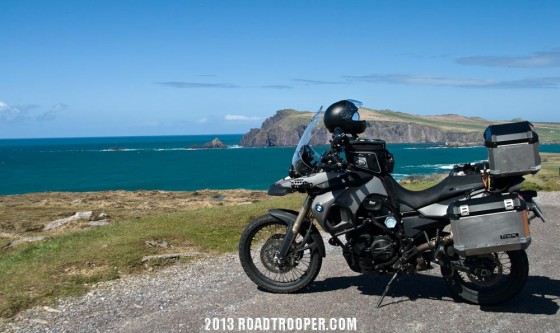
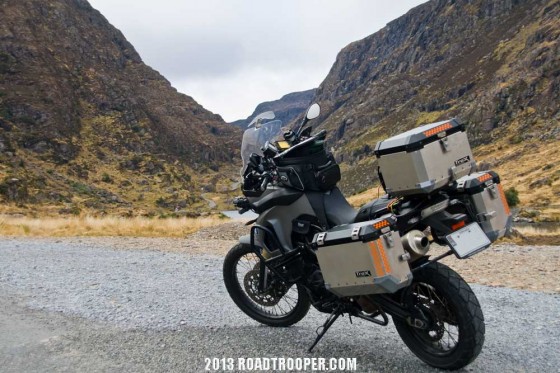
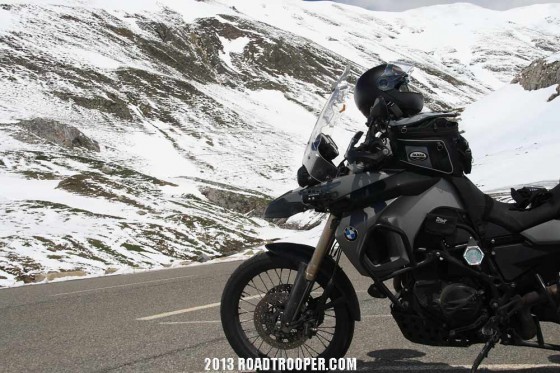
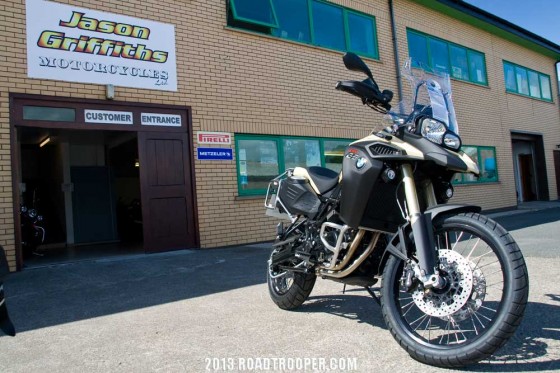
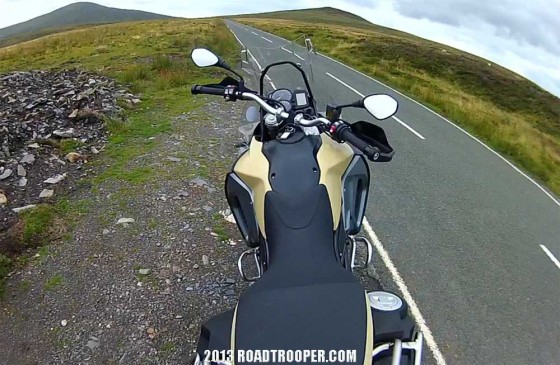
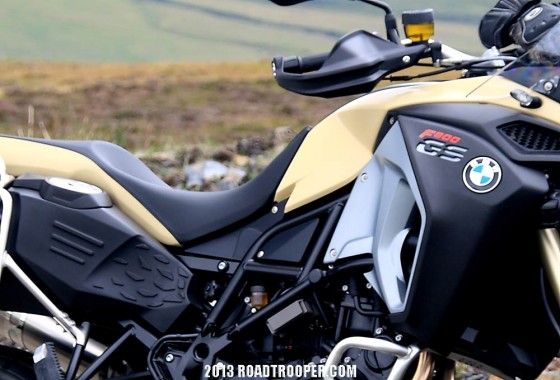
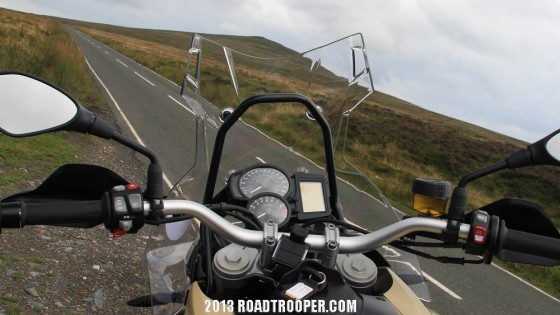
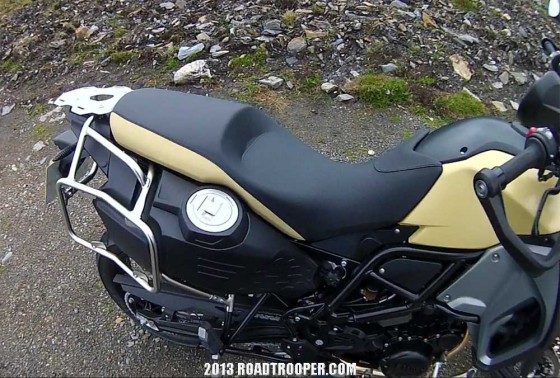
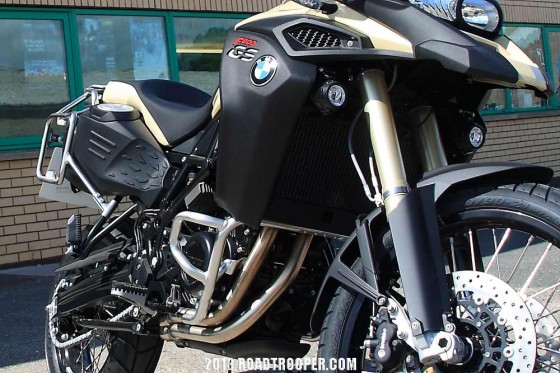
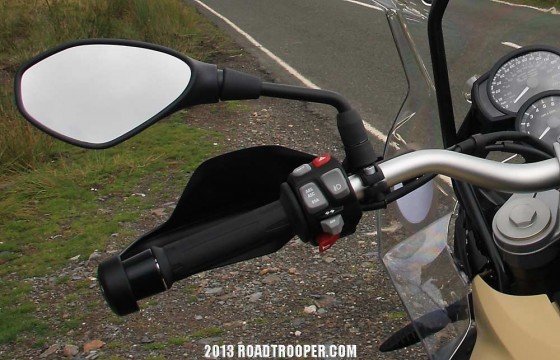
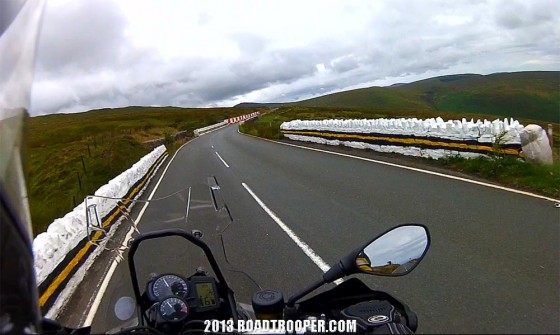
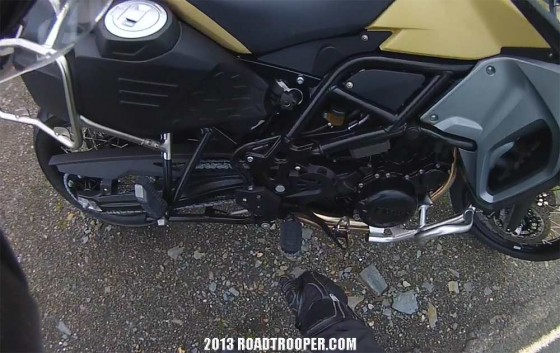
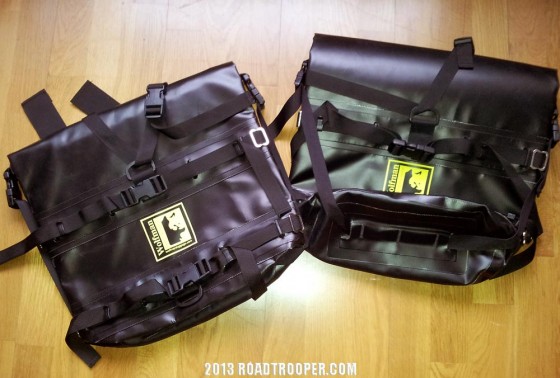
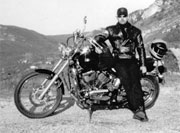







Denis, great review of the F800GS. When I get back to the U.S. I will be test driving one and making my final decision. I like the descriptive way you wrote how the metal panniers can affect driving through blind corners and such. As I will be traveling through Asia next year, I can now see how clipping a walker, another bike, or crazy Tuk-Tuk, can ruin a day for them or even worse, for me. Thank you
Glad you enjoyed the review. You might be happy to know I’m still loving the F800GSA, more-so every day, for me it’s a definite improvement over the standard F800GS – if you intend using it for distance touring.
I’ve had to put a few upgrades to it though. The engine bars and bash plate that come with the 800GSA are shall we say “limited” in their value. I’ve replaced these in favour for the Adventure-Spec set-up which are excellent and great value for money. The Adv-Spec bash plate is absolutely bomb proof and covers the prone oil filter, a major weak point for an off-roading F800GS/A. And I can also confirm the Adv-Spec engine bars which come up over the front fairing do a great job for low speed and standing drops – I’ve no intention of testing ‘em for a high speed drop
http://www.adventure-spec.com/default/catalogsearch/result/?q=F800GS+Adventure
I’ll probably end up replacing the hand guards too as they are not particularly solid, fine for keeping the winter wind off my paws, but that’s about it. As most will keep their F800GSA on the tar 98% of the time the hand guards that come with the bike are fine.
For each of these 3 upgrades it’s only if you know there is a high chance of dropping the bike, i.e. riding off the tar that you’d seriously consider these upgrades. If you only do road touring you only need these upgrades if you want to look the part and increase your chances of getting girls lol………. I love getting off the road, but have little skill in the dirt so I’m bound to drop it from time to time, hence the extra expense.
One last little upgrade to my 800GSA..
I’ve also fitted a Scottoiler, in my book it’s an essential item for any chain driven touring bike. On a pannier loaded F800GS I can easily get 6,000km on normal roads without needing to adjust/tighten the chain, even more depending on my riding. So for a mid range (1-2 week) tour I can leave some heavy duty tools at home as well as getting a longer chain/sprocket life.
From time to time (e.g. mid-tour or when I’ve been playing in the mud) I’ll temporarily increase the oil flow which effectively washes the chain. If on a really long tour and I run out of the Scottoil blue lube I’ll just add any clean engine oil to the Scottoiler dispenser and adjust the flow to suit the oil viscosity. They are expensive for their size, but definitely well worth the money for anyone riding long distances on a chain drive.
http://www.scottoiler.com
Safe riding,,
Denis
G`Day Denis,
Excellent review, very interesting and timely.
I`m from Australia and in my late 50`s. I`m currently returning back to riding after mainly doing the usual “off-road” stuff during my 20`s and 30`s on various bikes which progressed to a KTM500 and Maico490, but then had to give it away before I killed myself.
Boy, hasn`t motorcycle technology changed since then! But unfortunately my skill level, fitness and rebound from regular injuries is not what it used to be. So in my return to riding these days, I have decided to mainly do black-top riding, but I still have that urge to get into some occasional off-road stuff at a safer pace.
I`m currently looking at a few new bike options, so I test rode a new Tiger 800 XC a couple of days ago on local suburban roads. What a hoot and how silky smooth is that tripple! WOW!! I nearly committed to one on the spot, except old age and common sense told me to do more research, which I have and now I`m definitely undecided.
Since reading your excellent review on the BMW F 800 GSA and the opinion on your more street oriented Tiger, I will definitely need to take a GSA for test ride first.
Have you ever ridden the XC version of the Tiger or would most of its shortcomings still be similar to yours?
I welcome all comments and advice. Cheers!
Kind regards, Paul
G’Day Paul,
Sorry for late reply, I was making my way to Spain so just catching up on things now.
Motorcycle tech certainly has come a long way since I first climbed onto a bike over 25 years ago, most of it in a good way. As for the Tiger, I really liked many things about my Tiger 800, mainly the engine and the build quality. But it was also one of the few bikes I did not regret selling as it just did not suit me. I found it to be top heavy and the computer really annoyed me in that the function buttons can not be safely used while riding, they really should be bar mounted. The Triumphs computer is actually better than BMW’s, but as it can only be used when you have stopped it’s essentially pointless.
The Tiger was also a thursty bike and would plow through a full tank too quickly for me to consider using it for regular touring. I was averging only 44mpg, but on a spirited run it was more like 36mpg or less which buts the bike into the “weekend fun run” catagory for me and not the everyday and touring mile muncher.
I also tried the XC version, essentially it’s the same bike except that XC is a bit better on dirt tracks and the road version is unsurprisingly a little better at cornering. Compairing the Tiger XC against the 800GS on dirt tracks the GS wins out for me. I found the Tiger about as friendly as a rabid dog and far too top heavy in the dirt. For me at least the Tiger XC is strictly a road bike dressed up to look like a GS. There is nothing wrong with that and it suits many people. If you enjoy really spirited runs on surfaced roads and don’t have a problem with it’s fuel economy the Tigers make for a better road bike than the 800GS.
As for my 800GSA the engine is admittidly not as as exciting as the Tigers, but it’s plenty fast enough to be fun and gives me an average of 68-72mpg at motorway speeds and a range of almost 500km if i ride carefully. The 800GS/A has none of the other issues that annoyed me on the Tiger either, but everyones priorities are different.
It would be a good idea to try the 800GSA as it’s a brilliant bike, it’s cheap to run, easy to maintain and makes a first class long distance touring platform. If you get a test ride on one take it out for a good long 200km ride on as many different types of road as you can to give it a chance to impress. The secret to the 800GS’a usefulness is it’s ability to take on almost almost every type of road or dirt track. The only thing that really limits the bike is the rider or the tyres fitted. Let us know what you think of it yourself after the test ride.
Safe riding mate..
Denis
Hi Denis,
I must have read your F800GSA report about a dozen times over the last 6 months. Deciding to get a test ride and then not getting around to it. Anyway it’s time to bike swop and I’ve always liked adventure style bikes for their comfort and presence on the road so need to get another.
I’ve looked at the F800GSA in the dealers and everytime I walk around to the back it shouts “does my a*se look big in this?”, and that’s without the panniers. So did you ditch the alloy spam tins and go for the soft option?
Do you really think the Adventure is so much better than the standard GS?
Regards
Ian
Hi Ian,
A dozen times eh? I did not realise my writing skills were that good – or so bad that you had to read it 6 times to understand it lol…
As to your questions, there is no getting around it except that there are pros and cons to everything…..
As for the 800GSA’s arse looking big, well I see that not as a design issue, but more of a functionality issue. You only really have 2 choices when it comes to bikes with long range tanks, either stick the tank under the seat like the 800GSA, or up and in front of the rider position as in the 1200GSA – or most bikes with 3rd party extended tank setups.
Personally I prefer the 800GSA’s set up as the more traditional set up usually makes a bike feel very top heavy which for me makes life difficult on an already tall bike. Obviously with the 800GSA’s under and behind the rider tank placement I get the extra fuel without the bike getting very top heavy, and it lowers the overall center of gravity – but the ass does become bigger. This really matters little until of course you slap a couple of metal side cases on her and all hope of filtering goes out the window..
Although from my point of view the 1200GS/A becomes the size of a family saloon car with hard panniers fitted too, the width now being the same as the 800GSA. Actually all adv bikes get fat arses with hard cases, even the road version of the Tiger 800 is as wide as the 800/1200GSA with hard panniers on it. It wont matter what you buy, all adv bikes loose filtering ability with hard panniers fitted. If you get out a measuring tape and measure the width of a R1200RT with it’s moulded and tidy panniers fitted the difference between that and the 800GSA is barely 2cm. The main reason the hard cases look so unusually big on the F800GS/A is because the bike is tall and skinny to begin with.
For shorter trips, or solo trips on surfaced roads I now use soft panniers, I chose to go for the Wolfman Expedition Dry Panniers, available in the UK from Adventure-Spec.com. I’ve been using them for a year and find them excellent, they’re 100% waterproof and can hold 38 liters which along with a top box is more than enough for a 4 week solo trip. Good quality soft panniers are usually the way to go as they keep your bikes ability to filter and maneuver on tight roads. They also stop you from packing the kitchen sink which many folks seem to think is necessary – even for a long weekend! Although if you’re camping that extra space comes in handy for carrying the beer..
Remember however, soft panniers have a downside. Firstly you can’t park your bike in the center of Milan and go for a walkabout and still expect your gear to be in your panniers on your return. And 2nd, if you intend to ride off road and you have a fall soft panniers are liable to rip open, nor will they protect you or your bike like metal panniers can. At the end of the day, its the type of roads and location that you intend to ride that will dictate a decision to go for hard or soft panniers. Pro’s and cons to everything.
Do I really think the 800GS Adventure is so much better than the standard GS? For me – yes but not necessarily for you.
There are only 2 real differences between the standard model and the Adv model. Firstly it’s slightly more comfortable, better and wider saddle and more wind protection, so for long distance days it’s a better option, a regular standard ride for me is 300km, a long day more likely to be 800-1000km. If your in that ball game then the 800GSA might be a better option. The 2nd big difference is the fat ass tank which will allow me to push 450-490km before a refill. Again for me this is a big bonus as I prefer to ride out into the middle of nowhere, well off the beaten track with few places to find fuel and here in Spain thats been an issue for me more than once.
However, if I was permanently living back in Ireland or the UK I’d never really be riding 800km + in a day, nor would I ever be more than 20km from the nearest petrol station, nor would said petrol station likely be closed for siesta when I need it most. If that were the case I’d as likely choose a standard 800GS.. For me the 800GSA is an “almost all terrain”, long distance tourer that 100% suits my needs, it’s a tool to do a job and I bought it using my head and not my heart. If I used my heart I’d buy a Ducati. The 800GSA is not a pretty bike by any means but it ticks all my functional boxes – except for good looks, but a Ducati it is not.
My mother once told me never to marry and overly beautiful woman. Great to have on your arm yes, but she will never cook, most likely be highly strung, will most definitely be high maintenance and every scumbag will try to steal her. A bit like a Ducati
Simplest way to put it is this, assuming it’s a BMW you’re after. If you seriously intend to do long distance touring on and off road then it’s the 1200GSA or 800GSA. If it’s mid range touring on and off road it’s the standard 800GS. If it’s mid or long range touring on paved roads in real comfort then it’s the 1200GS or RT. And if you can, test ride all of ‘em as they are all brilliant, you just need to pick the right tool for the job (riding) you intend to do. In this case it’s better to act like a teenager and ride as many as you can before you marry one, eh, sorry, I mean buy one…..
Hope this helps, let me know what you eventually decide on..
Denis
+
Denis,
I came across your reports recently and I as many others enjoy your insight tremendously. Do you already know when you will be launching the article regarding Wild Atlantic Way? I bought in October a F800GSA and still be very pleased with it, surely it is a bit early to say much about it, just after 1.200 km, but it feels real good. I might be as well interested in touring with you next year in case you get the tour into September. For me as a re-starter after 30 years I still need to gain some local experience in Germany.
I am happy that I learned about your website.
Kind regards
Martin
Hi Martin, it’s great to hear you are finding the website useful. I still have to write the article on the Wild Atlantic Way but I hope to have it done by the end of January. At the moment I’m working as fast as I can building a new and hopefully more useful RT website that will also be smartphone and ipad friendly. However I will be uploading all the maps and routes for the Wild Atlantic Way in the next few days. I’ll let everyone know as soon as they are online and ready to download through my FaceBook Page
I’ll be returning to ride part of the Wild Atlantic Way in September starting in Dublin on the 2nd and finishing around 1pm on the Sligo/Donegal border on the 8th after which I’ll be riding to Belfast to get the ferry to the Isle of Man. You are more than welcome to join us. Here’s my itinerary accommodations that I’ve booked into along the way if you would like to book the same places yourself. You can book them all online using booking.com with the exception of The Beach Bar B&B on the 7th, to make a booking here you will have to contact them by email beachbarireland@gmail.com but best by phone and ask for Darren +353 (0) 719176465
We will be riding aproximatly 250km per day which will take aproximatly 8-9 hours to complete as the roads are small limiting our average speed to aprox 40kmph. However I can send you the route as a Google Map, Garmin .GDB or .GPX so you can’t get lost You can also choose your own speed and shorter routes for yourself and meet up for food an beers in the evening. However, if traveling to the West of Ireland I would recommend booking the accommodation very soon as the area will be busy and many of the hotels are already full during those dates. I will also be riding in the western Basque Pyrenees for a 4, maybe 5 days in early May, but I have not yet got exact dates for this as it will greatly depend on when the high passes are likely to open.
You can also choose your own speed and shorter routes for yourself and meet up for food an beers in the evening. However, if traveling to the West of Ireland I would recommend booking the accommodation very soon as the area will be busy and many of the hotels are already full during those dates. I will also be riding in the western Basque Pyrenees for a 4, maybe 5 days in early May, but I have not yet got exact dates for this as it will greatly depend on when the high passes are likely to open.
This years ininerary is:
Day 1 Check In 2nd Sept – http://www.booking.com/hotel/ie/the-old-imperial-youghal.html
Day 2 Check In 3rd Sept – http://www.booking.com/hotel/ie/glengarriff-park.html
Day 3 Check In 4th Sept – http://www.booking.com/hotel/ie/the-anvil-bar.html
Day 4 Check In 5th Sept – http://www.booking.com/hotel/ie/hylandsburrenhotel.html
Day 5 Check In 6th Sept – http://www.booking.com/hotel/ie/newport-newport.html
Day 6 Check In 7th Sept – The Beach Bar B&B Sligo http://www.thebeachbarsligo.com
Day 7 Check In 8th Sept – http://www.booking.com/hotel/gb/corr-s-corner.html (Optional)
All the best,
Denis
Hi great review!
I have three questions.
You say that your height is 5’9”/170cm, but 5’9”=179cm.
What is the right? I wonder because i like the F800GS and
i am thinking to buy one, but my height is 5’6”/170cm and
i wonder if i will have problem with this.
The second is about touring ability/ best touring speed in the
highways. What is the ideal speed for touring??
Is the bike good enough for two passengers touring and comfortable
for both of the riders??
Hi, sorry for the slow reply but I had to find time to answer your questions properly.
Firstly you’re right, my height is 5’9”/179cm and not 170cm, my mistake there.
At 170cm you might have a problem with the stock seat height in the beginning, tall bikes get a bit of getting used to. You’ll have to get used to getting on/off differently than low bikes, also you need to get used to only having one foot on the ground while stopped with the other foot remaining on the foot peg. Tall bikes generally have narrow seats to help facilitate this. There are plenty of vids on YouTube giving tips on this technique, there is a slight learning curve which anyone can master and there are plenty of folks shorter than 170cm riding bikes taller than the 800GS. It took me a few weeks to get used to the 800GS height, now it’s second nature to the point that bikes with lower seats feel weird.
When I bought the 800GS I decided to get the low seat which gave me more confidence as it was a very different type of bike to what I was used too, but now I mostly use the standard seat as I find the low seat too low. However you might find the low seat a option better for you.
The 800GS is a great bike for solo touring, it will happily do 130kph for days on end returning around 58-62mpg with 68mpg-70mpg at 100kph. However if you are looking to do long distance touring with big motorway distances of 700-1000km in a day you really need to get a touring screen, the stock fly screen is perfect for trails/greenlanes etc but they don’t work well on motorways. The stock saddle is comfortable enough for 300km, less for a pillion, after that it becomes a pain if not unbearable. The best solution for this is the AirHawk Seat or at the very least a gel pad. For you I’d recommend using the low seat + the AirHawk + touring/tall screen for touring and you’ll happily cross continents.
Touring with a pillion is a different ball game, personally I think the stock 800GS is not very well suited for this for a number or reasons, all of which are fixable, but at a cost. You have to realize though that the F800GS was never designed for two-up touring in the first place! Neither the frame, suspension, tyres nor brakes are comparable to the likes of the 1200GS which was designed with rider + pillion in mind. If I wanted to do a big tour of Europe with my wife I’d choose the 1200GS to do it on.
Firstly the front forks are too softly sprung, at the best of times they dip heavily if you need to grab the brakes for a quick stop and a pillion is not going to enjoy that! This becomes a bigger issue if you roll into a corner too fast, if you don’t know how to handle the bike you can easily find yourself loosing control and end up parking in a tree. The soft front end suspension is a common complaint with all 800GS owners. It’s ok for solo riding, but the extra weight of a pillion drastically changes the dynamic of the bike. The biggest blight of the bike is the lack of valving in the fork and springs that are two soft. Both of those problems are solvable by a suspension specialist or a cartridge kit and then there no qualms with the bikes handling.
Alternatively the BMW ESA (Electronic Suspension Adjust) works well, slipping the ESA into Sport Mode firms up the bike to compensate for a pillion. I however flatly refuse to take a pillion on a 800GS with a standard stock suspension setup.
Another safety issue to consider is the tubed tyres. These do not suit two up touring! Firstly you need to carry extra tools to fix a flat, that’s more weight you don’t want. The big issue however is the way tubed tyres deflate, i.e. very quickly or possibly explosively which is more likely with the extra weight and extra psi in your tyres. In the admittedly unlikely event you were to pick up a sharp object causing a puncture at any speed you’ll have little to no hope of bringing the bike to a safe and controlled stop with a pillion. In 24 years of riding bikes a blow-out on the rear tyre has only happened to me once, but fuck me sideways if I ever want to experience that again. Due to that experience I’ll never accept the responsibility and take a pillion on any bike with tubed tyres. Tubeless are a much safer option for two-up touring, they also last longer as they don’t run as hot. Because tubed tyres run hotter you will also have to ride slower (120kph max, 110kph to be safe) if riding in hot weather with a pillion on a motorway on tubed tyres. There are other tyre matters to consider too for two-up touring. The 800GS has a 21” front wheel which limits your tyre choice, basically you’re stuck with dual sport tyres like Pirelli Scorpion Trails or Anakee III’s neither of which are as good at road touring as 100% road tyres. For solo riding they are fine, but if you accept the responsibility of carrying a pillion you should really aim for the best tyres possible for wet weather grip and braking. The sad truth is that in an off the pillion almost always receives more serious injuries. Also, as far as I am aware today, the Pirelli Scorpions and the Anakee III are the only tyres tested and recommended by BMW. This means that if you chose any other tyre your motorcycle insurance company may NOT cover you in the event of an accident.
The issue with tubed tyres can be solved by fitting Alpina tubeless rims, but they are not cheap! If you also add in the cost of fixing the suspension you’re already spending almost the same as you would for a 1200GS which as I mentioned before is a far better option for two-up touring.
All of this really depends on what type of two-up touring you’re talking about. If you simply intend an occasional trip where you will not be using the motorway or doing high speeds or long distances then you will be fine on a stock 800GS. But if you want to cross Europe and ride in the Pyrenees or Alps you need to spend a lot of money (€2500-€3000) turning the 800GS into a capable touring bike for two-up touring. If this is the case you really need to consider a 1200GS or the likes of maybe the Tiger 800.
I love the 800GS, I have both the standard 800GS which I love using for trail riding, solo touring and everyday use. I also have the 800GS Adventure with ESA and Alpina Tubeless Rims fitted which I use for long distance touring or riding with a pillion. However when touring I always ride solo, if I decided to do much touring with a pillion I’d probably sell the 800GSA and buy a 1200GS as it’s much better suited, and safer for two-up touring.
Hope this info helps with your decision.
Safe riding,
Denis
Well, I did not see all of the articles on heat with the f800 GSA and now own one 2017. The only thing I want to figure out is how to stop the heat on to my shin/right side. Wrap the exhaust headers?
Can anyone contact me and tell me how to solve the issue.
john.cowen@csaa.com
Hi John,
The only time I’ve ever had an issue with heat from the bike on my right side is in very hot conditions (30C/90F+) when stuck in traffic and the fan kicks in and fires baking hot air at my right inner leg. It’s not an issue at all on cool days as the fan rearly, if ever comes on. If it’s hot air from the fan then I’m not sure there is a solution as the fan needs to cool off the engine.
D